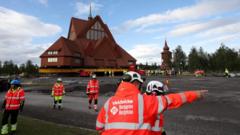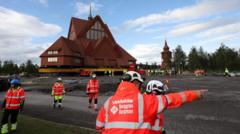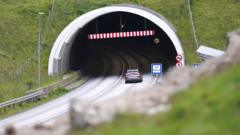Kiruna Church, a cultural emblem, is being transported 5km to preserve its legacy amid the town's remarkable relocation due to iron ore mining impacts.
**Historic Relocation of Kiruna Church Embarks on Two-Day Journey**

**Historic Relocation of Kiruna Church Embarks on Two-Day Journey**
A monumental effort unfolds in Kiruna, Sweden as a century-old church is moved to safeguard it from mining-related subsidence.
The picturesque Kiruna Church, constructed in 1912, is in the midst of a planned relocation to ensure its stability as the surrounding area suffers from ground subsidence caused by over a century of iron ore extraction. With a height of 35 meters (115 feet) and a weight of 672 tonnes, this iconic structure is being moved in its entirety on colossal rolling platforms across a carefully prepared route in the northern Swedish city.
This massive undertaking, planned to span two days and travel at a pace of up to 500 meters per hour, stands as a testament to the community's resilience and adaptability amid their city's ongoing transformation. As thousand of residents, including dignitaries such as King Carl Gustaf, gather to witness the event, cultural strategist Sofia Lagerlöf Määttä remarked, "it's like finally, let’s get it done. We've been waiting for so many years."
Stefan Holmblad Johansson, who leads the operation, emphasized the complexity and significance of the task, stating, "It's a historic event, a very big and complex operation and we don't have a margin of error." Preparations for the move required extensive efforts, including road expansions to accommodate the transporters and ensuring the church's delicate interiors remain intact during the transition.
As part of the project, the church's distinguished artwork, including the notable altar painting, remains secured within its walls throughout the move. Vicar Lena Tjärnberg expressed the emotional weight of the church's relocation, acknowledging its deep-rooted importance to the community. "The church is leaving a place where it truly belongs," Tjärnberg noted, reflecting on the bittersweet nature of the transition.
The relocation forms part of a broader strategy to shift buildings in Kiruna to safe ground. As the city's primary employer, industrial giant LKAB is funding the significant undertaking, with an estimated cost exceeding 10 billion Swedish krona ($1 billion). Not only does this relocation preserve the church as a spiritual home, but it also reinforces the connection between the community's heritage and its future as it undertakes this transformative journey.
This massive undertaking, planned to span two days and travel at a pace of up to 500 meters per hour, stands as a testament to the community's resilience and adaptability amid their city's ongoing transformation. As thousand of residents, including dignitaries such as King Carl Gustaf, gather to witness the event, cultural strategist Sofia Lagerlöf Määttä remarked, "it's like finally, let’s get it done. We've been waiting for so many years."
Stefan Holmblad Johansson, who leads the operation, emphasized the complexity and significance of the task, stating, "It's a historic event, a very big and complex operation and we don't have a margin of error." Preparations for the move required extensive efforts, including road expansions to accommodate the transporters and ensuring the church's delicate interiors remain intact during the transition.
As part of the project, the church's distinguished artwork, including the notable altar painting, remains secured within its walls throughout the move. Vicar Lena Tjärnberg expressed the emotional weight of the church's relocation, acknowledging its deep-rooted importance to the community. "The church is leaving a place where it truly belongs," Tjärnberg noted, reflecting on the bittersweet nature of the transition.
The relocation forms part of a broader strategy to shift buildings in Kiruna to safe ground. As the city's primary employer, industrial giant LKAB is funding the significant undertaking, with an estimated cost exceeding 10 billion Swedish krona ($1 billion). Not only does this relocation preserve the church as a spiritual home, but it also reinforces the connection between the community's heritage and its future as it undertakes this transformative journey.





















